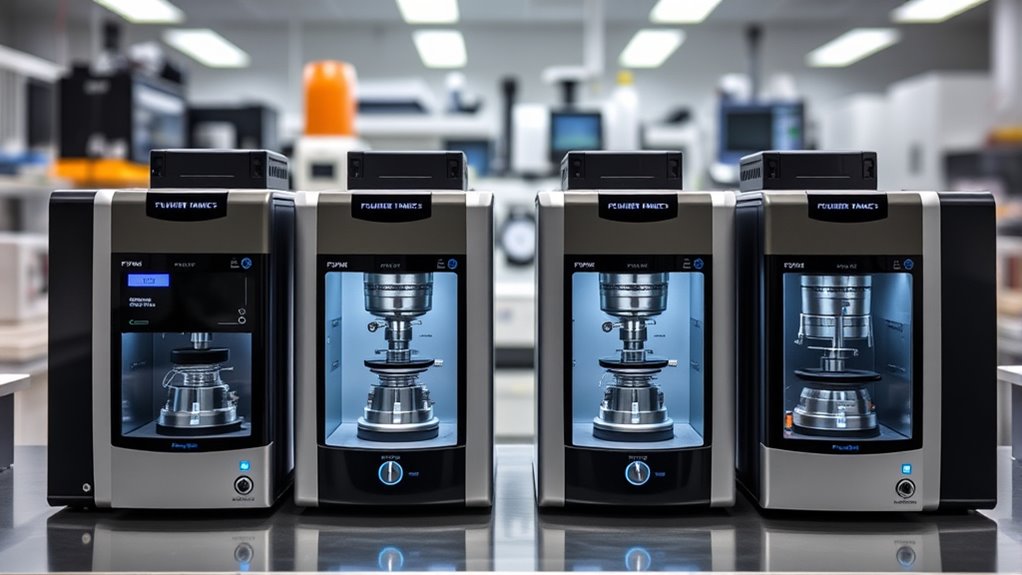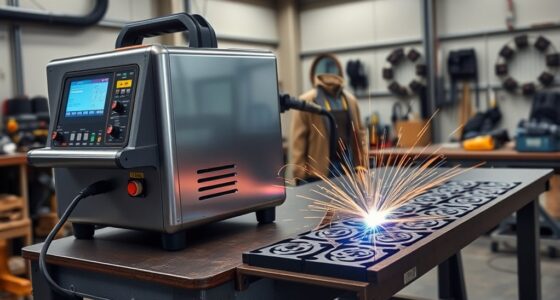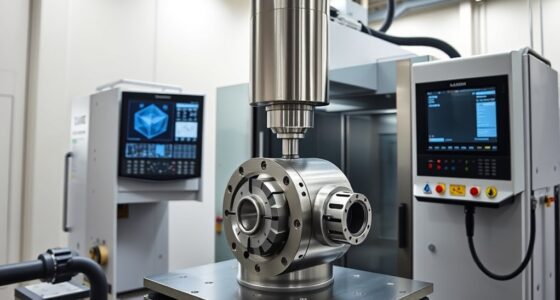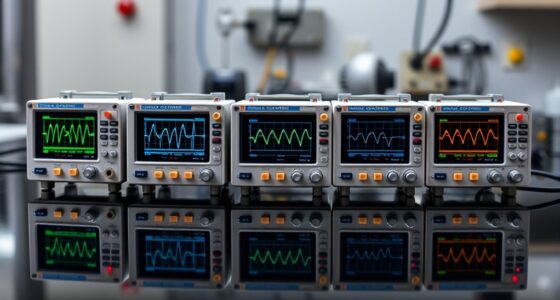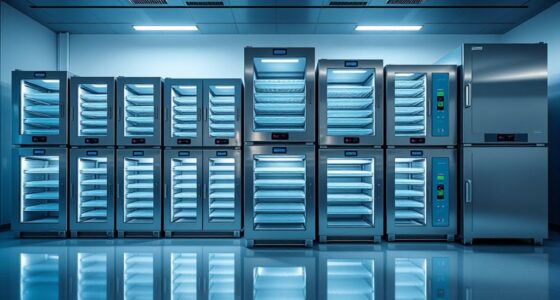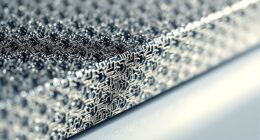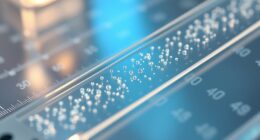If you’re looking for the 14 best Fourier Transform Infrared spectrometers, I recommend options that cover a broad spectral range, offer high resolution, and are durable enough for various environments. From handheld models for field use to advanced lab systems, these devices provide accurate, reliable results for research, quality control, and medical applications. To find out which one suits your needs best and explore their features, keep going—you’ll discover plenty of valuable info ahead.
Key Takeaways
- The list highlights spectrometers with broad spectral ranges, high resolution, and precise measurement capabilities for accurate analysis.
- It features portable, user-friendly designs suitable for field, industrial, research, and educational applications.
- Many models offer advanced data analysis tools, real-time visualization, and reliable calibration for consistent results.
- Connectivity options like Bluetooth, Wi-Fi, and USB facilitate seamless data transfer and integration with software.
- The selection encompasses devices tailored for diverse uses such as spectral analysis, LED testing, medical diagnostics, and environmental monitoring.
Handheld Spectrometer for Light Measurement (340-1000nm) with APP & PC Software
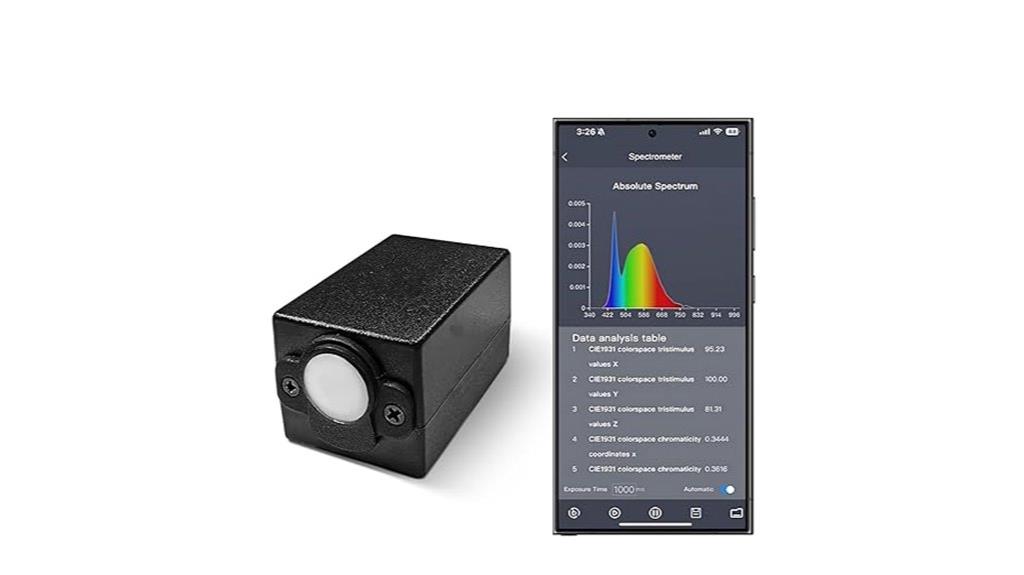
If you’re looking for a portable solution to measure light across the UV to near-infrared spectrum, this handheld spectrometer is an excellent choice. It covers 340-1000nm, making it perfect for diverse applications like lighting performance, plant growth, and color analysis. Its compact size (47x28x25mm, 23g) and lightweight design guarantee easy field use. With a USB Type-C connection, it offers real-time data on CCT, CRI, PAR, and PPFD directly to Android devices. Plus, its dedicated app and PC software enable quick measurements, data management, and professional reporting—making it a versatile tool for professionals on the go.
Best For: professionals and researchers needing portable, accurate light measurement across UV to near-infrared ranges for applications in lighting, horticulture, and scientific analysis.
Pros:
- Compact and lightweight design for easy field portability
- Real-time measurement data via USB Type-C connection with Android devices
- Versatile application support including lighting evaluation, plant growth testing, and color analysis
Cons:
- Limited to the 340-1000nm spectrum, not suitable for applications requiring broader wavelengths
- Requires compatible Android device and dedicated app for operation
- PC software may have a learning curve for new users
Fourier Transform Infrared Spectrometry Book 171
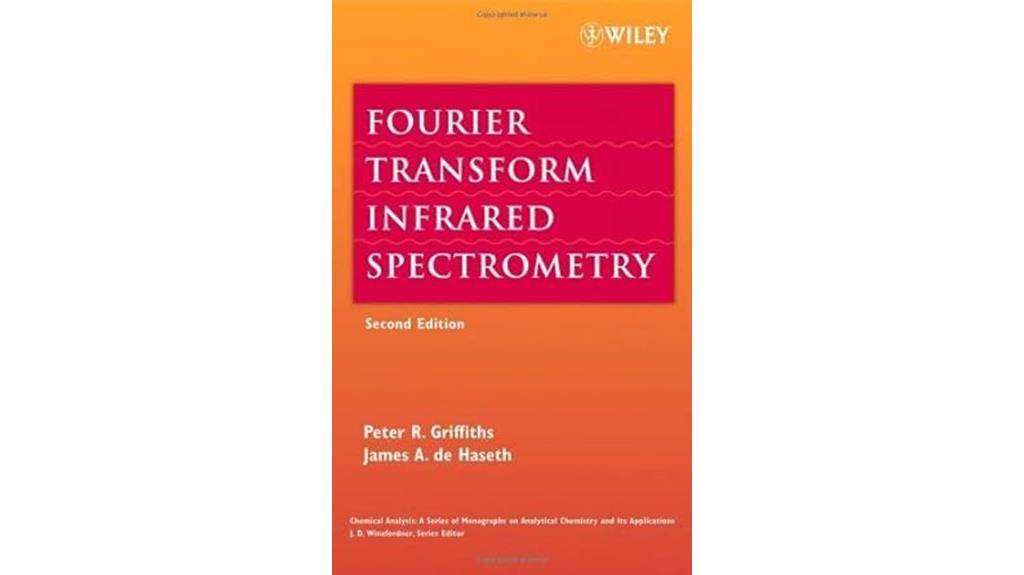
Fourier Transform Infrared Spectrometry Book 171 stands out as an essential resource for advanced chemists and professionals involved in spectroscopy. I find it to be an exhaustive reference that explains how FT-IR spectrometers function, covering physics, hardware, and practical techniques. The second edition offers valuable updates, making it even more relevant for those designing, troubleshooting, or interpreting FT-IR data. Its detailed diagrams and spectra are best appreciated in print. I recommend this book for anyone seeking a solid foundation or advanced insights into FT-IR technology, especially for its all-encompassing coverage of instrument design and characterization. It’s a must-have for serious spectroscopists.
Best For: advanced chemists, spectroscopy professionals, and instrument designers seeking comprehensive insights into FT-IR technology and practical applications.
Pros:
- In-depth coverage of FT-IR physics, hardware, and design considerations.
- Detailed diagrams, spectra, and technical explanations suitable for advanced users.
- Valuable resource for troubleshooting, instrument characterization, and understanding spectral data.
Cons:
- Slightly dated content, requiring verification of the latest edition for current updates.
- Limited coverage of alignment techniques and some instrument design aspects.
- Best suited for print due to better visual clarity of diagrams and spectra, which may be less optimal in digital formats.
OHSP350IRS NIR Spectrometer with LED Wavelength Meter and PC Software

The OHSP350IRS NIR Spectrometer stands out as an ideal choice for professionals and researchers who need precise, portable spectral measurements in the 760-1100 nm range. Its handheld design features a 5-inch LCD display for quick data readout and lightweight construction for easy transport. The device’s long focal length optical system provides 1 nm resolution, ensuring accurate measurements of irradiance and wavelength. Paired with PC software, it produces colorful graphs for detailed data analysis. Its auto zeroing and adjustable integration time guarantee consistent, rapid results. Perfect for applications like medical therapies, security, and research, it combines portability with high performance.
Best For: professionals and researchers needing portable, precise spectral measurements in the 760-1100 nm range for applications like medical therapies, security, and scientific research.
Pros:
- Portable handheld design with a 5-inch LCD display for easy data readout
- High 1 nm optical resolution ensures accurate wavelength and irradiance measurements
- PC software provides colorful graphs for detailed analysis and enhanced usability
Cons:
- Limited to the 760-1100 nm wavelength range, not suitable for broader spectral analysis
- Requires familiarity with spectral data interpretation and software operation
- May be less ideal for stationary laboratory setups compared to larger spectrometers
Portable UV Spectrometer Analyzer (JDY-F2300)
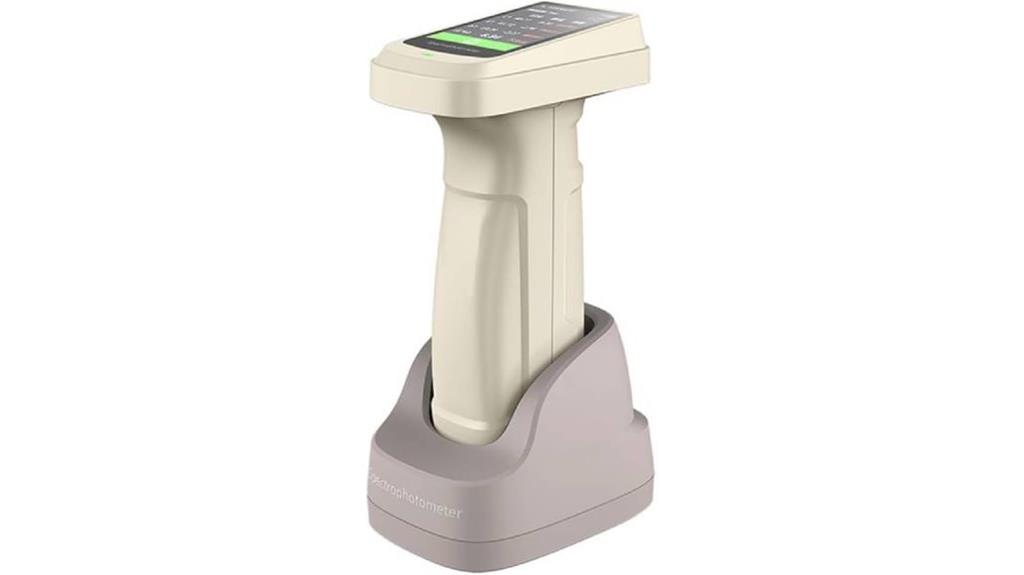
Designed for professionals needing quick, accurate spectral measurements in the field or laboratory, the Portable UV Spectrometer Analyzer (JDY-F2300) offers automatic calibration and high measurement precision. Its double light road sensor array ensures reliable results across a broad spectral range (360-700nm), supported by full-band LED and UV light sources. With over 30 measurement parameters and 37 evaluation light sources, it handles diverse sample types efficiently. Compact and lightweight, it features a handheld design with a USB interface for easy data transfer. Its fast measurement time (1-1.5 seconds) and compatibility with software make it ideal for on-the-go analysis, combining versatility with user-friendly operation.
Best For: professionals and researchers needing quick, accurate spectral analysis in the field or laboratory environments.
Pros:
- Supports automatic calibration, ensuring high measurement accuracy with minimal user intervention
- Wide spectral range (360-700nm) with multiple measurement parameters and evaluation light sources for versatile sample analysis
- Compact, lightweight, and portable design with quick measurement time (1-1.5 seconds) for efficient on-the-go use
Cons:
- Limited to spectral measurements within the 360-700nm range, which may not cover all specific research needs
- Requires USB connection and compatible software, possibly limiting use in environments without compatible devices
- Slightly higher initial investment due to advanced features and portable design
OHSP350IR Spectrometer with PC Software

If you’re looking for a reliable handheld spectrometer that offers precise light measurement and easy data analysis, the OHSP350IR with PC software is an excellent choice. It covers a wavelength range of 380-1050nm with a spectral resolution of 0.2nm, ensuring detailed spectral data. Its lightweight design and 5-inch LCD make on-the-spot readings straightforward, while the included software provides colorful graph outputs and extensive analysis tools. Features like automatic zeroing, electronic shutter technology, and quick machine switching simplify operation. Powered by a 4000mAh battery, it delivers up to 24 hours of continuous testing, making it ideal for measuring LEDs, red lamps, and other light sources both in the lab and on the go.
Best For: researchers, lighting engineers, and professionals who need precise spectral measurement and easy data analysis of LED and light sources in both lab and field environments.
Pros:
- High spectral resolution of 0.2nm for detailed spectral analysis
- User-friendly 5-inch LCD and PC software for straightforward data readout and colorful graph outputs
- Long battery life with up to 24 hours of continuous testing, suitable for extended use
Cons:
- Some users have experienced issues with defective units and difficulty with returns
- Limited information on customer support and after-sales service quality
- Price may be higher compared to basic spectrometers with fewer features
EISCO Premium Quantitative Spectroscope
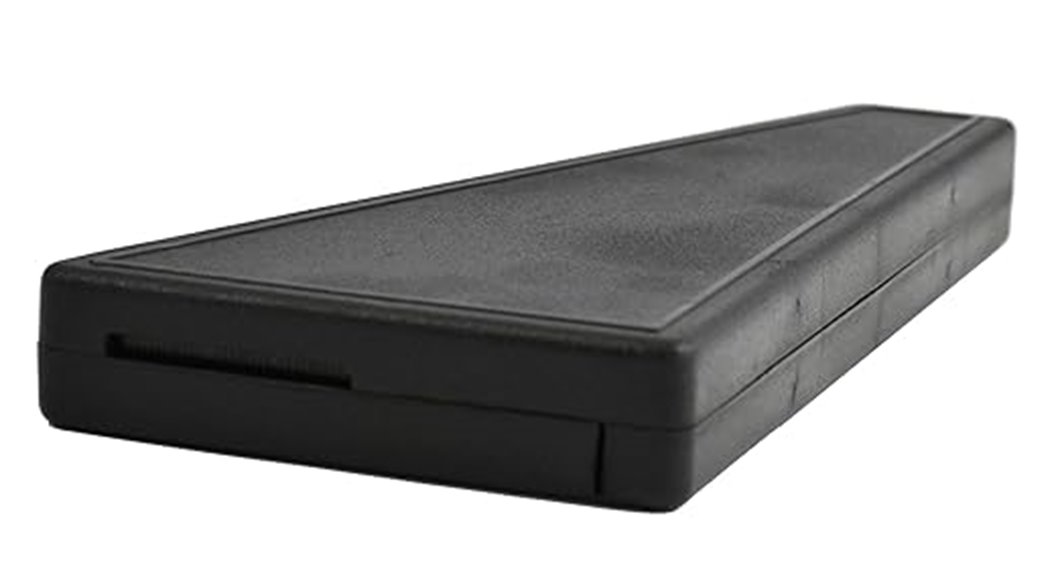
For researchers and students seeking precise spectral measurements across the visible range, the EISCO Premium Quantitative Spectroscope stands out with its high-resolution diffraction grating and wide measurement capabilities. It covers wavelengths from 400 to 700 nm, enabling detailed analysis of color spectra, light sources, and flame tests. Its innovative design guarantees clear readings without tape or adjustments, thanks to a secure holder for the diffraction grating and scale. Equipped with a 500 lines/mm diffraction grating, it delivers high resolution and dependable results. With an accuracy of ±5.0 nm, it provides reliable data for experiments, spectroscopy studies, and educational purposes, making it an excellent choice for precise spectral analysis.
Best For: students, educators, and researchers needing precise and reliable spectral analysis of light sources within the visible spectrum.
Pros:
- Wide measurement range from 400.0 to 700.0nm for comprehensive spectral coverage
- High-resolution diffraction grating (500 lines/mm) for detailed observations
- Innovative design ensures clear, legible readings without tape or adjustments
Cons:
- Measurement accuracy is limited to +/- 5.0nm, which may not suffice for ultra-precision needs
- May require careful handling to maintain alignment and calibration over time
- Designed primarily for visible spectrum analysis; not suitable for ultraviolet or infrared wavelengths
OHSP350S Spectrometer Grow Light Tester IR Spectrometer Lab Equipment
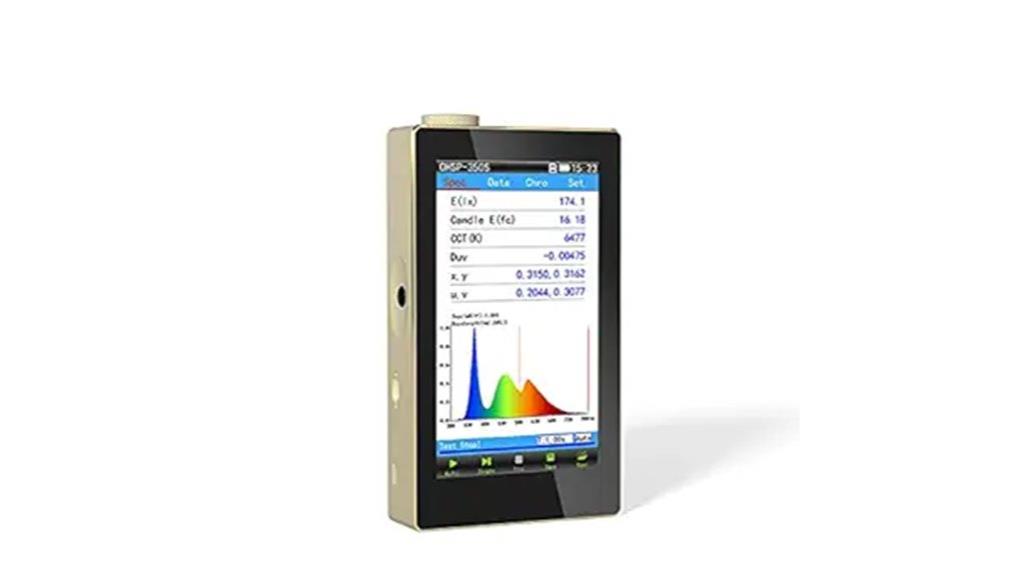
The OHSP350S Spectrometer Grow Light Tester IR Spectrometer Lab Equipment stands out with its compact, handheld design, making it ideal for professionals who need accurate spectral analysis on the go. Its lightweight build allows easy transport and operation in tight spaces or remote locations. The device features a long focal length optical system with 2 nm resolution and a high-performance linear CCD sensor covering 350 to 950 nm. It provides precise measurements of lux, CCT, CRI, PPFD, and other parameters. The 5-inch LCD displays data instantly, while software enables detailed graph analysis. Overall, it’s a versatile, portable tool perfect for grow light testing and laboratory applications.
Best For: professionals and researchers who require portable, precise spectral analysis of grow lights and lab samples in various environments.
Pros:
- Compact, lightweight, and highly portable for easy transport and use in tight spaces.
- Wide wavelength range (350-950 nm) with high resolution (2 nm) for accurate spectral measurements.
- User-friendly interface with a 5-inch LCD and software support for detailed data visualization.
Cons:
- May have a learning curve for new users unfamiliar with spectral analysis equipment.
- Limited to spectroscopic measurements within the 350-950 nm range, not suitable for beyond this scope.
- The device’s manual and software features might require additional training or technical support for optimal use.
High-Precision LED Phototherapy Light Meter
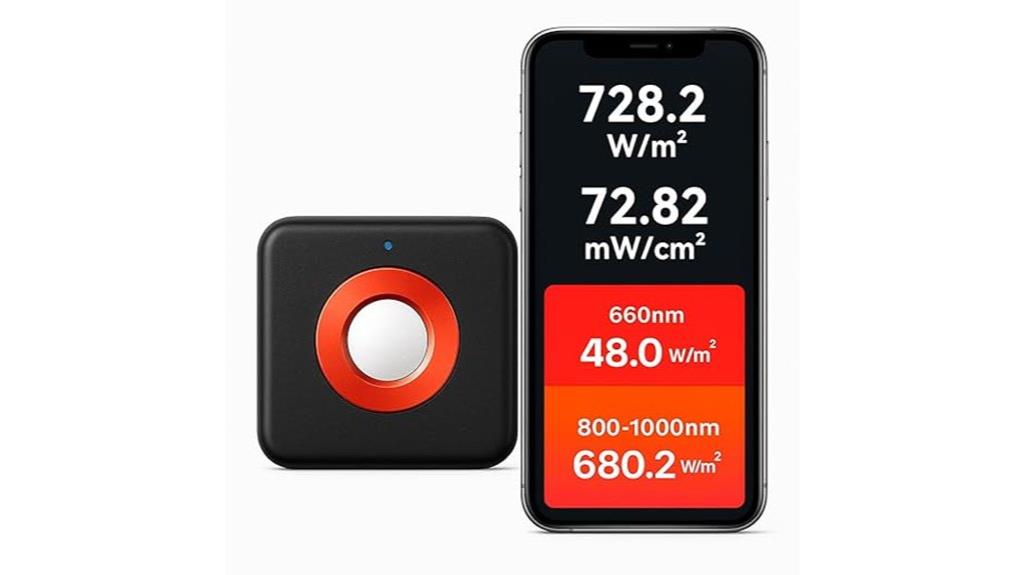
High-Precision LED Phototherapy Light Meter stands out with its dual-band measurement capability, allowing users to accurately monitor both red (660nm) and near-infrared (800–1000nm) light simultaneously. Equipped with advanced Japanese photodiode sensors, it ensures precise wavelength accuracy within ±5 nm and stable intensity readings through built-in calibration. This device captures full red and NIR spectra, verifying both surface and deep-tissue light doses with one tool. Its Bluetooth connectivity pairs effortlessly with a mobile app, providing real-time irradiance measurements in mW/cm² or W/m². Designed for reliability, it guarantees ideal phototherapy treatment by delivering accurate, extensive light intensity data.
Best For: medical professionals, researchers, and therapists seeking precise, real-time measurement of red and near-infrared light for effective phototherapy treatments.
Pros:
- Accurate dual-band measurement of 660nm red and 800–1000nm NIR light
- Wavelength accuracy within ±5 nm with stable readings via built-in calibration
- Bluetooth connectivity with a user-friendly mobile app for real-time data display
Cons:
- May require initial setup and calibration for optimal performance
- Limited to specific wavelengths (red and NIR), not suitable for other light spectra
- Dependency on mobile devices for full functionality could be inconvenient in some settings
Fundamentals of Fourier Transform Infrared Spectroscopy
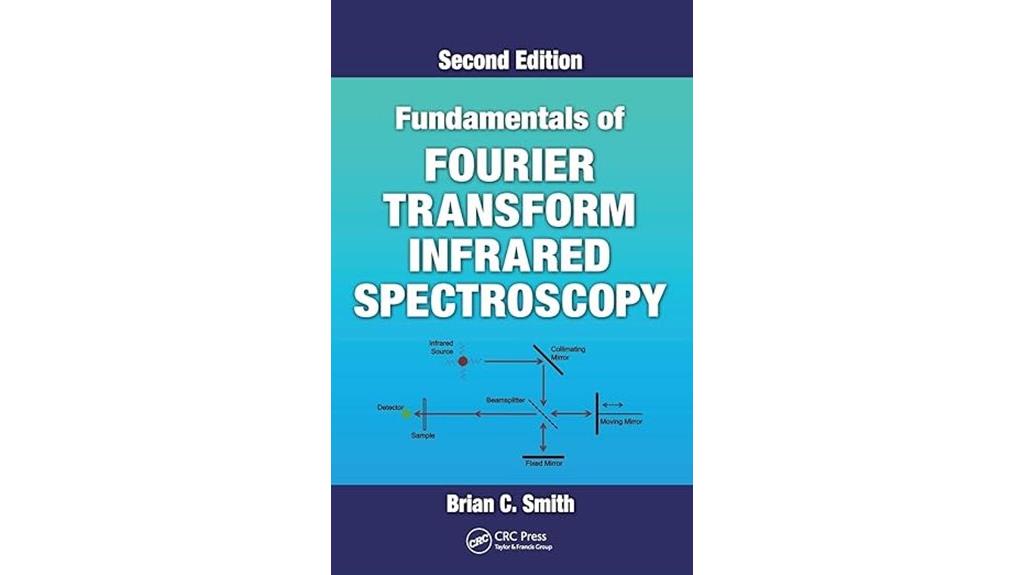
If you’re new to FTIR and looking for an approachable introduction, Fourier Transform Infrared Spectroscopy offers an ideal starting point. I find it’s a powerful technique that provides detailed molecular information by measuring how materials absorb infrared light. The core idea involves capturing an interferogram and applying a Fourier transform to generate a spectrum. This method simplifies data collection and improves signal-to-noise ratios. Although the math behind it can seem complex, the fundamentals are straightforward—focused on understanding how different chemical bonds interact with infrared light. This foundation helps beginners grasp FTIR’s capabilities and guides more advanced exploration later on.
Best For: beginners and students seeking an accessible, well-structured introduction to FTIR fundamentals with minimal math.
Pros:
- Clear explanations tailored for newcomers, including those with limited technical backgrounds
- Well-organized content with numerous illustrations and practical examples
- Serves as a useful quick reference and refresher for experienced spectroscopists
Cons:
- Limited coverage of IR microscopy techniques, which could be expanded
- Focuses mainly on organic substances, with fewer inorganic examples
- Minimal mathematical detail, requiring readers to consult additional texts for in-depth Fourier transform understanding
Advanced Spectrometer for Light Measurement and Analysis
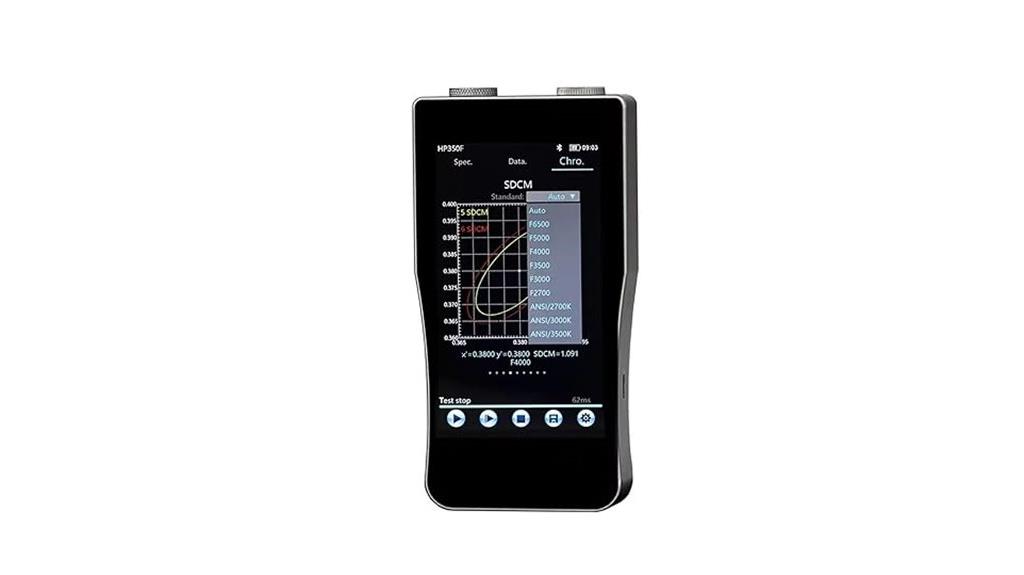
For professionals seeking accurate and exhaustive light measurements, this advanced spectrometer offers an impressive array of features. It measures spectrum, flicker, strobe frequency, CCT, CRI, lux, and PAR, providing comprehensive light analysis. Its flicker detection tests both visible and invisible flicker, ensuring eye safety and high lighting quality. With lab-grade sensors, it delivers high-precision, reliable results comparable to benchtop devices. Wireless connectivity allows real-time data transfer to computers and smartphones, enabling quick analysis and reporting. Whether for LED manufacturing, film production, or scientific research, this spectrometer delivers versatile, professional-grade performance across industries.
Best For: professionals in LED manufacturing, film production, architectural lighting, and scientific research seeking precise and comprehensive light measurement tools.
Pros:
- Offers a wide range of measurement capabilities including spectrum, flicker, CCT, CRI, lux, and PAR for thorough light analysis
- Equipped with lab-grade sensors ensuring high accuracy and reliable results comparable to benchtop instruments
- Wireless connectivity facilitates real-time data transfer, analysis, and reporting via computers and smartphones
Cons:
- May be more expensive than basic light meters due to its advanced features
- Complexity of features could require some training for optimal use
- Battery life might be limited during extensive field measurements
GOYOJO Portable Spectrophotometer 721

The GOYOJO Portable Spectrophotometer 721 stands out as an ideal choice for professionals seeking reliable and accurate spectral measurements in the field or laboratory. Its high photometric accuracy of ±1%T and repeatability of 0.5%T ensure dependable results, while stability of ±0.004A/h at 500nm supports long-term experiments. The device features a user-friendly design with straightforward operation and a clear digital display, making it accessible to all experience levels. Its versatile measurement range of 0-200%T and -0.3A to 3A suits research, diagnostics, and quality control across various industries. Built for durability and portability, it’s a practical tool for precise spectral analysis anywhere.
Best For: professionals in research, clinical diagnostics, and quality control seeking reliable, accurate spectral measurements in laboratory or field settings.
Pros:
- High photometric accuracy of ±1%T and repeatability of 0.5%T for dependable results
- Stable operation with ±0.004A/h at 500nm, suitable for long-term experiments
- User-friendly design with clear digital display and straightforward operation
Cons:
- Limited to 110V power supply, may require adapters for international use
- Measurement range may not cover extremely high or low absorbance samples
- Portability may be constrained by the device’s size and power needs in some environments
Spectrometer Handheld Spectrum Analyzer for LED Grow Lights
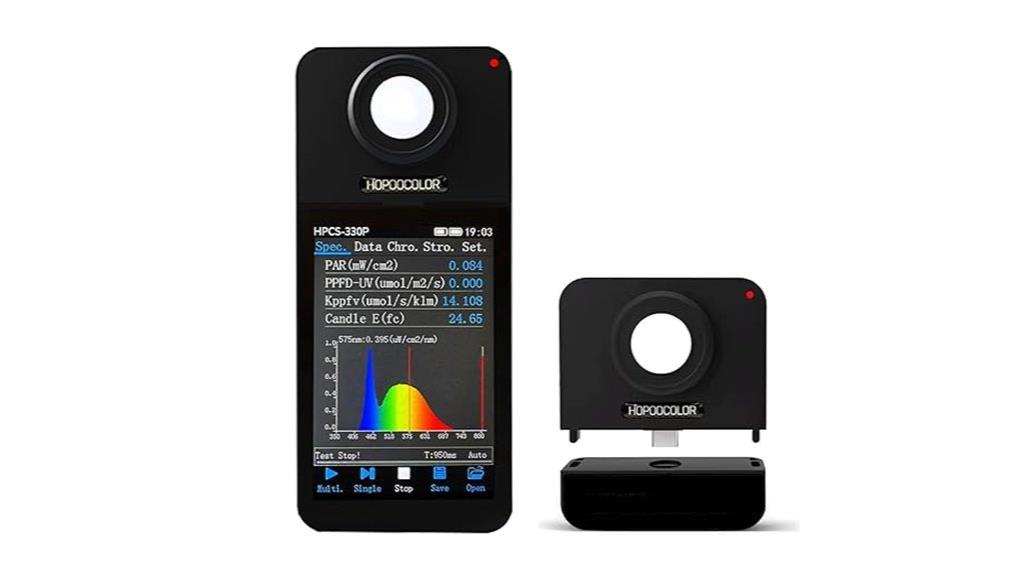
The handheld spectrum analyzer, specifically the Spectrometer 330P, excels at evaluating LED grow lights with its precise spectral measurement capabilities. It captures detailed spectral data from 350 to 800 nm, essential for assessing light quality for plant growth and research. With a measurement range from 5 to 200,000 lux, it provides accurate illumination readings. Its user-friendly design features a 3.5-inch touch LCD screen and a removable probe for flexible use in various environments. The included PC software enables thorough data analysis, export, and documentation, making it an ideal tool for researchers, growers, and lighting professionals seeking reliable, on-the-spot light evaluations.
Best For: horticulturists, researchers, and lighting professionals seeking precise, portable spectral analysis of LED grow lights and other illumination sources.
Pros:
- Accurate spectral measurement from 350 to 800 nm for detailed light analysis
- Portable design with a 3.5-inch touch LCD and removable probe for versatile use
- Includes software for comprehensive data processing, export, and documentation
Cons:
- Requires some understanding of spectral data for proper interpretation
- Limited to a wavelength range of 350-800 nm, excluding UV and IR spectrums
- Dependency on USB connection for advanced analysis may limit use in remote locations
USB Spectrometer – C Spectrometer
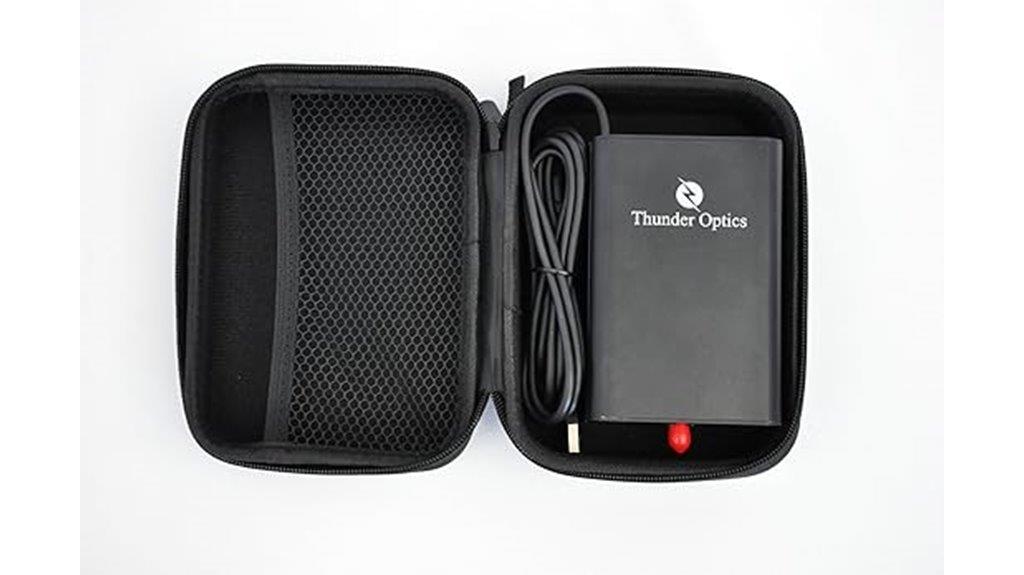
If you’re a student or hobbyist seeking an affordable yet capable spectrometer, the USB Spectrometer – C Spectrometer is an excellent choice. It’s calibrated for accurate measurements and connects easily via USB, making it user-friendly. Its extended wavelength range of 350-880nm covers many common applications, from basic spectroscopy to material analysis. With a resolution under 1.5 at 550nm, it provides clear, detailed data. The device features a sturdy metallic slit (100µm), ensuring durability and consistent performance. Its compact design and straightforward connectivity make it ideal for experimental needs, offering reliable results without the complexity or high cost of professional-grade equipment.
Best For: students and hobbyists seeking an affordable, reliable spectrometer for educational and experimental applications.
Pros:
- Calibrated for accurate and consistent measurements
- Extended wavelength range of 350-880nm suitable for various applications
- Durable metallic slit (100µm) ensures longevity and stable performance
Cons:
- Resolution less than 1.5 at 550nm may not be sufficient for highly detailed analyses
- Limited to USB connectivity, which may not be compatible with all devices
- Designed primarily for educational and hobbyist use, not professional-grade research
BN320 Handheld Spectrometer Light Spectrum Meter
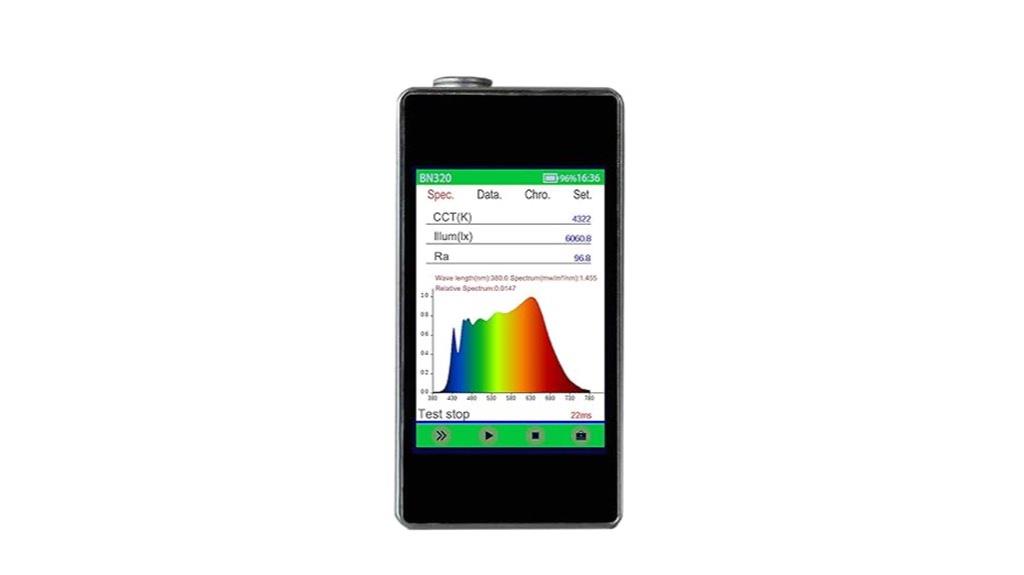
Designed for professionals needing precise spectral measurements in the field, the BN320 Handheld Spectrometer Light Spectrum Meter stands out with its advanced telephoto crossed asymmetric CT spectroscopic system. It delivers a spectral distinguishability of 0.2nm and a bandwidth of 2nm, ensuring accurate data across 380nm-780nm. The high-precision CCD sensor provides Class 1 illuminance accuracy and chromaticity coordinates within ±0.0025, supporting critical color assessments. Its intuitive 3.5-inch touchscreen simplifies operation, while its compact, lightweight design and 12-hour battery life make it ideal for on-the-go use. With robust data storage and fast Type-C transfer, it’s a reliable tool for field spectral analysis.
Best For: professionals and field technicians requiring precise spectral measurements and color assessments in diverse outdoor and industrial environments.
Pros:
- High spectral distinguishability of 0.2nm and a bandwidth of 2nm for accurate measurements
- Class 1 illuminance accuracy and precise chromaticity coordinates for reliable data quality
- Long-lasting 12-hour battery life with portable, lightweight design for field use
Cons:
- May be costly for casual or non-professional users
- Limited spectral range of 380nm-780nm, not suitable for UV or IR measurements
- Requires familiarity with spectral measurement technology for optimal operation
Factors to Consider When Choosing Fourier Transform Infrared Spectrometers
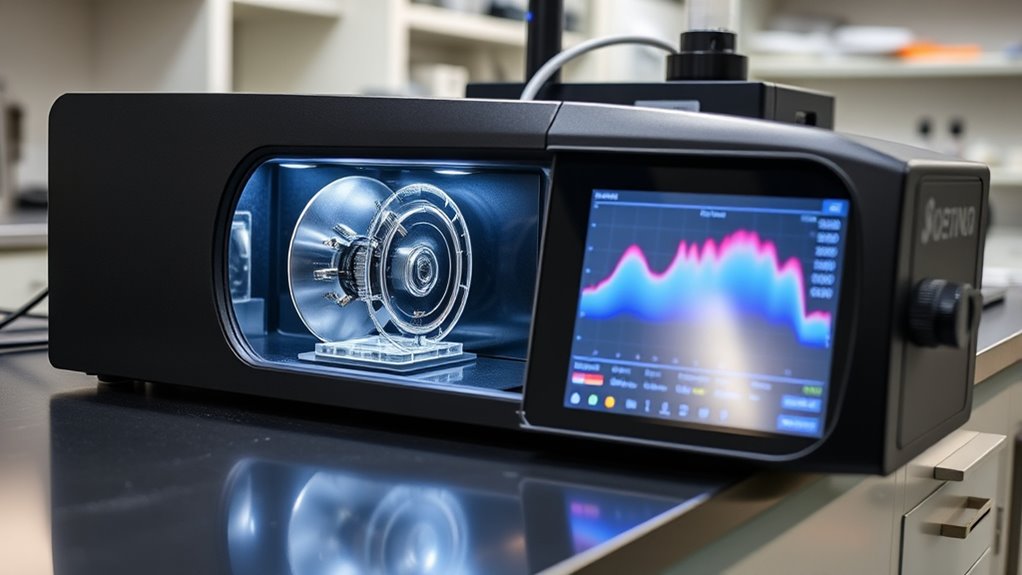
When selecting a Fourier Transform Infrared spectrometer, I focus on several key factors to guarantee it meets my needs. These include spectral range coverage, resolution, sensitivity, hardware compatibility, data analysis features, and durability. Considering these points helps me choose an instrument that delivers accurate results and reliable performance.
Spectral Range Coverage
Choosing the right FTIR spectrometer involves carefully considering its spectral range to guarantee it captures the wavelengths relevant to your analysis. I look for an instrument that covers the mid-infrared region (4000–400 cm⁻¹), which is essential for most molecular vibrations, and may extend into near-infrared wavelengths up to 2500 nm for broader applications. It’s important to verify that the spectral coverage includes the absorption bands of the materials or compounds I plan to analyze, such as organic or inorganic substances. A wider spectral range offers more versatility, enabling detection of various functional groups. Additionally, I check if the spectrometer allows for extending its range with accessories or different detectors, ensuring it meets my specific research needs and aligns with industry standards for accurate data interpretation.
Resolution and Sensitivity
High resolution and sensitivity are critical factors that determine how effectively an FTIR spectrometer can distinguish between closely spaced spectral features and detect weak signals. Higher resolution, typically between 0.5 and 2 cm⁻¹, enables precise differentiation of overlapping peaks, essential for detailed material analysis. Sensitivity, influenced by detector type and signal-to-noise ratio, affects the ability to identify faint absorbance signals, which is crucial when analyzing dilute samples or minor components within complex mixtures. Achieving ideal resolution and sensitivity involves balancing optical design, detector quality, and noise reduction techniques. A well-chosen FTIR instrument with these features ensures accurate, reliable results and enhances your analytical capabilities across diverse applications.
Hardware Compatibility
Selecting the right FTIR spectrometer hinges on ensuring its hardware components are compatible with your existing lab equipment and analytical needs. I carefully evaluate detectors and light sources to confirm they match my current setups and can handle my sample types. The interface—whether USB, Ethernet, or Wi-Fi—must integrate seamlessly with my data acquisition systems. I also check if the hardware covers the spectral range and resolution required for accurate analysis of my materials. Additionally, I look for modularity, ensuring upgrades or accessories can be added later as my research evolves. Durability is key; the hardware must withstand environmental conditions like temperature fluctuations, humidity, and vibration. Compatibility in these areas guarantees reliable performance and future-proofing my investment.
Data Analysis Features
When evaluating FTIR spectrometers, I pay close attention to their data analysis features, since accurate interpretation is key to meaningful results. I look for devices with advanced data processing tools like baseline correction, peak deconvolution, and spectral smoothing to refine analysis accuracy. It’s also important that the software offers flexible data export options—such as PDF, CSV, or SPC formats—to facilitate seamless integration with reporting and analysis tools. I check whether the software includes spectral libraries or databases, which help quickly identify unknown samples. Additionally, real-time data visualization and multi-parameter measurement support, including absorbance, transmittance, and reflectance, enhance interpretative capabilities. Automated report generation features are also valuable for efficient documentation and comprehensive result presentation.
Instrument Durability
Have you considered how ruggedness impacts the longevity of an FTIR spectrometer? Durability is essential, especially in harsh environments. Look for models with robust metal housings and impact-resistant parts to withstand physical shocks and accidental drops. The optical components, like windows and filters, should resist dust, moisture, and chemical vapors, ensuring consistent performance over time. Thermal fluctuations and vibrations can affect measurement stability, so choose instruments designed to handle these stresses, especially for field use. Regular calibration and maintenance features help extend the lifespan by addressing wear and environmental damage. A rugged design, including sealed enclosures and shock absorption, guarantees reliable operation during transportation and prolonged use in demanding conditions. Investing in durable FTIR spectrometers saves money and minimizes downtime.
Frequently Asked Questions
What Is the Optimal Spectral Range for Fourier Transform Infrared Spectrometers?
The ideal spectral range for Fourier Transform Infrared (FTIR) spectrometers typically spans from about 4000 to 400 cm⁻¹. I find this range perfect because it covers most molecular vibrations, providing extensive analysis. For specific applications like polymer or gas analysis, I might choose instruments with extended ranges. Overall, this standard range balances sensitivity and resolution, making it versatile for a wide variety of samples.
How Does Resolution Impact FTIR Spectrometer Accuracy?
Resolution is the lens through which I see the fine details of a sample’s spectrum. Higher resolution sharpens this view, revealing subtle peaks and nuances that improve accuracy. However, it’s like trying to focus a camera; too high can create noise, too low can blur details. Finding the right balance guarantees I get precise, reliable results without sacrificing clarity, making my analysis as clear as a perfectly focused image.
Which Features Enhance Portability in FTIR Spectrometers?
Portability in FTIR spectrometers is mainly enhanced by lightweight design, compact size, and battery operation. I look for models with sturdy, ergonomic casings that are easy to carry and set up in the field. Wireless connectivity and integrated displays also make analysis more flexible. These features allow me to perform accurate, reliable measurements on-site without sacrificing ease of use or precision.
How Do FTIR Spectrometers Handle Sample Preparation?
FTIR spectrometers handle sample preparation by allowing quick and straightforward processes. I typically prepare samples as solids, liquids, or gases, often using simple methods like pellet pressing, liquid cell placement, or gas flow cells. These techniques minimize preparation time and reduce potential errors. I appreciate models with accessories that streamline this process, making it easier and more efficient to obtain accurate spectral data without extensive sample handling.
What Maintenance Is Required for Long-Term Spectrometer Reliability?
To guarantee long-term reliability, I regularly clean the optical components, such as the interferometer mirrors and beamsplitters, to prevent dust buildup. I also change the purge gas filters as needed and keep the instrument calibrated with standard samples. Additionally, I follow the manufacturer’s maintenance schedule, check for software updates, and handle any issues promptly. Proper storage and avoiding harsh environments also help extend the spectrometer’s lifespan.
Conclusion
In wrapping up, I recommend weighing the wondrous options based on your specific needs. Whether you’re seeking a sleek, portable spectrometer or a sophisticated, software-savvy system, the right device delivers dependable, detailed data. Don’t forget to contemplate cost, convenience, and compatibility. By boldly balancing these brilliant benefits, you’ll confidently choose the spectrometer suited for superior, steadfast science—making your measurements more meaningful, manageable, and memorable.
